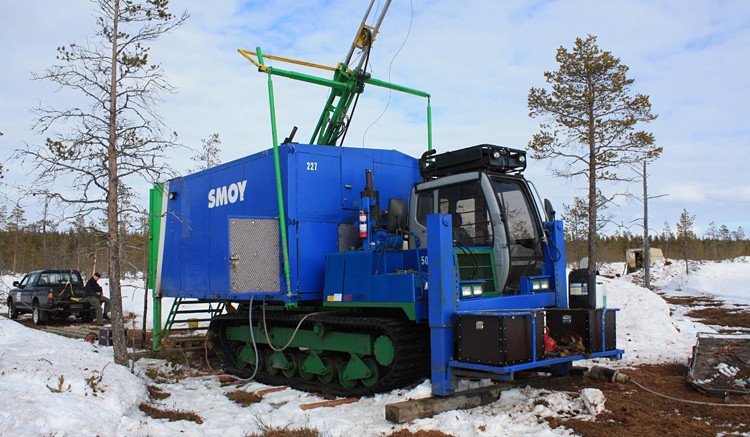Finland has taken the heavyweight title as the world’s best mining jurisdiction, fending off last year’s winner, New Brunswick, which slipped to fourth behind Sweden and Alberta, the Fraser Institute reports in its annual mining survey.
This is the first year since the 2006–07 survey that a Canadian jurisdiction did not take the top prize. But Canada’s average Policy Potential Index score — which assesses the overall policy attractiveness of 96 jurisdictions worldwide — improved slightly, despite only taking three of the top-10 slots, compared to five last year.
“Canada did really well in the survey and has [Alberta, New Brunswick and the Yukon] in the top ten, and we also saw a lot of movement up in the territories this year too, which was great to see,” the survey’s co-author Alana Wilson says, noting while the country remains globally competitive, there were some concerns about disputed land claims and Aboriginal consultations.
Alberta — third overall and unchanged from last year — now ranks as Canada’s most attractive mining spot, with New Brunswick trailing in fourth and Yukon in eighth, climbing up from tenth last year.
“Alberta and New Brunswick offer competitive taxation regimes, sound legal systems and relatively low uncertainty around land claims. That’s what miners are looking for,” says Kenneth Green, the director of the Fraser Institute’s Survey of Mining Companies: 2012 to 2013.
Respondents included 742 executives from mining-related companies, who were asked how 15 policy factors — such as environmental regulations, disputed land claims and taxation regimes — affected their decision to invest in 96 jurisdictions, which now includes French Guiana, Greece and Serbia.
Both Quebec and Saskatchewan fell out of the best ten, finishing at eleventh and thirteenth. Quebec came in fifth last year and continued its descent this year, after ranking as the world’s top-mining region from 2007 to 2010.
“It still is a competitive jurisdiction for mining investment, although it has slipped down a bit over the years . . . to drop from number-one to eleventh in three years is a bit of a concern, since it would indicate that the policies in place — especially the uncertainty around the potential policies — are starting to have an impact on how it rates,” Wilson says.
Compared to last year, the province scored lower on the questions assessing political stability and the uncertainty concerning the administration’s interpretation and enforcement of existing regulations, Wilson explains, adding that these are the areas where Quebec has dipped before in the survey.
“Uncertainty is dissuasive to investment, since mining is such a long-term investment. If policies or rules are changed partway through, or if there is uncertainty with whether changes are coming, it really erodes investor confidence.”
Other top-10 finalists include Wyoming in fifth, followed by Ireland and Nevada, with Utah and Norway coming in ninth and tenth. All the finalists appeared in this category last year, except for Utah and Norway.
Norway jumped to tenth from twenty-fourth last year. The survey notes that Sweden — now in second — and Finland have been in the final 10 for the last three and four years, respectively.
“The Nordic countries, especially their prominence in the top ten, shows the importance of sound policies in guiding mining investments,” Wilson says.
On the flip side, the least favourable region was Indonesia at ninety-sixth, followed by Vietnam, Venezuela, the Democratic Republic of the Congo (DRC), Kyrgyzstan, Zimbabwe, Bolivia, Guatemala, the Philippines and Greece.
The DRC and Zimbabwe weren’t in the bottom 10 last year, but have dropped considerably now, with the DRC diving from seventy-sixth to ninety-third, and Zimbabwe from seventy-forth to ninety-first.
According to the report, Africa’s overall Policy Potential Index score declined, continuing a five-year descent, with Mali plunging the most, down 37 spots to seventy-ninth. Botswana remained the top African jurisdiction to invest in, ranking seventeenth on a global scale, right behind Ontario.
Jurisdictions that climbed out of the bottom 10 this year include Honduras, moving from last place — or ninety-third to eighty-third — and India, advancing seven spots to eighty-first.
The report shows that miners are tightening their purse strings, with only 46% saying they expect to increase their exploration budgets this year, compared to 68% a year ago.
Miners also appear bearish on short-term commodity prices, reporting in general that they expect reduced prices for silver, copper, coal, nickel, platinum, potash and diamonds over the next two years. The only exception was gold, anticipated to add more than 20% in value in the near-term.
Looking at long-term prices, miners were more optimistic, projecting stable or moderate price increases over the next 10 years.
At last, respondents were asked about the difficulties of raising funds compared to two years ago, and 90% agreed it was tougher to finance in today’s environment, with the majority attributing it to investors fretting over the health of the global economy, or losing their appetite for risk.


Be the first to comment on "Finland is the No. 1 spot for mining: Fraser Institute"